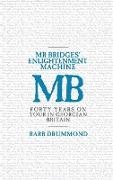Read more
In 1733 Mr Henry Bridges of Waltham Abbey advertised his giant machine was on display at his house. It was called the Microcosm because it described his world with moving scened of his carpentry trade, of the wider world with travel, commerce and industry, a clock which displayed the heavens in real time, moving scenes of the muses, of orheus and the coming of spring, and the top was a riot of musical instruments. For forty years the show travelled by road and water the length and breadth of Britain, southern Ireland and even the West Indies and North America where it was seen by Washington.
Many comparisons have been made between Bridges' machine and other large clockwork displays, but none were as complex, none claimed to inspire, educate and entertain, and none had such an extended career, or generated so much publicity in the press or via pamphlets, handbills and engravings.
This is not just the story of Henry. His son James Bridges rebuilt Bristol bridge and claimed all he knew was from his father, so this highlights the informal spread of knowlege within Britain. Travelling shows were oportunities for master craftsmen to see the finest workmanship, to ask questions and to improve and share their skills with other visitors. It challenges the notion of gentelmen as experts, and the role played by wealthy patrons in identifying and supporting talented artists and craftsmen, and the vital role that child prodigies and women played in the rise of Britain from its centuries of violence and disruption. It also highights the role of the early freemasons in promoting and spreading scientific and technical knowledge both locally and internationally.
The entertainment aspect of the show highlights the importance of play and imagination in creativity. The shows often encouraged women and children to attend. Even if they gained little from the show, their entrance fees helped support the show, hence encouraged the expansion and development of skills and knowledge.
Questions are also raised as to why a provincial carpenter would build such a complex mechanism. How did he find the time and money? Where did he learn his skills? But ultimately, why did he do it? Was it built on commission for, eitehr the Duke of Chandos or the Prince of Wales? If so, why did they not receive it? If built on speculation, what was the plan? Who funded it? And why?
When the machine vanished, Britain was spending more money on chinese tea and china, so had a huge imbalance in international trade. the Microcosm seems to have been drawn into the attempt to balance this via he extraorinary business of James Cox who produced giant jeweled automata for the Chinese market, but when this collapsed he tried to liquidate his assets via a lottery which became a huge story in itself, but like the Mikcrocosm has largely vanished from the historic record.
The publicity for the Microcosm often bemoaned the passion of the English for foreign imports at the expense of local tradesmen. It urged readers to be warmed by English fire. This is not nationalism in the modern sense, but encouragement for the English to work harder, to be inspired, to regain the skills and trades that had been lost by the Tudor Reformation.
About the author
Barb Drummond has been self publishing British history for several decades. She has done research for the British Empire and Commonwealth Museum and worked with the BBC.

